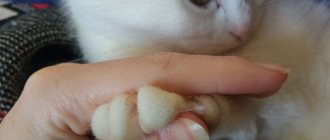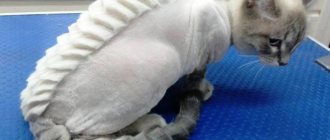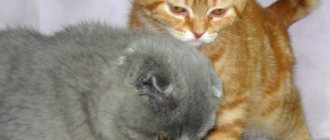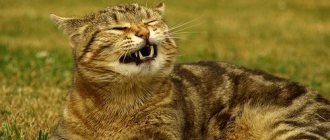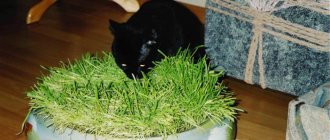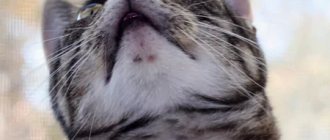Under natural conditions, animals quietly get rid of keratinized particles in the process of moving on hard surfaces, while climbing trees, hunting, etc. At home, pets do not have this opportunity, therefore, if the cat is not accustomed to a scratching post, furniture, etc., are used. walls, carpets.
Do not rush to punish the fluffy - just carry out hygienic trimming of the claws. It is performed using a special tool - a nail clipper. You can find several types of this device in pet stores.
Why do you need to do a cat manicure?
Cats' claws invariably grow, and they need to be tidied up - trimmed using a special nail clipper. Overgrown claws can cause discomfort to the animal or cause injury.
In nature, cats walk on hard surfaces or wear down their claws on trees and other convenient objects. At home, animals are deprived of this opportunity and cannot do without human help. Therefore, from time to time they need the so-called cat “manicure”.
Overgrown claws can become ingrown or cause discomfort when walking. The cat may also get caught in a carpet loop or some piece of furniture, which will lead to a finger injury and medical intervention.
When their claws grow long enough, cats begin to grind them down themselves. In the best case – on a scratching post, in the worst – on wallpaper or furniture. Timely manicure is the key to the cat’s health and the integrity of the owner’s sofa.
First aid for injuries
Even experienced owners may experience situations where the pruning procedure becomes stressful. This could be due to a huge number of factors, ranging from a dull instrument to a sharp sound outside the window that frightened the pet.
It is important to remain calm and clearly understand the algorithm of actions in the event of an injury.
Pulp trauma
If the pruning is done too short, there is a high risk of damaging a large number of blood vessels. In this case, heavy bleeding and sharp pain occur;
This is interesting: Microdermal what is it
It is the owner's job to stop the bleeding and calm the dog. Try to distract your pet. You should not shout at him, because the animal is in severe pain;
Using brilliant green, an alcohol solution of iodine, or other alcohol-containing antiseptics will only increase the pain. Therefore, many breeders prefer to treat open wounds with antiseptic powder.
You might find our article useful: Home veterinary first aid kit for dogs
This is important: If an injury occurs, and the first aid kit does not have the necessary medications, then experts advise stopping the bleeding with the help of flour.
Claw detonation
This situation arises in case of uncertain actions of the owner. Slow squeezing of the nail clipper by the owner in combination with a sharp jerk of the paw at the moment of manipulation can lead to disastrous results.
As a result, the claw becomes caught in the instrument and the skin and soft tissues rupture. The owner should:
- Remember that this is very painful for your four-legged pet. Therefore, he will try to break free and run away;
- The injured limb should be bandaged with gauze or a tourniquet in the metatarsal area; Raise the limb upward to stop bleeding;
- Apply cold to the injured paw. This could be an ice pack, food or fruit from the freezer;
- Open lesions should be treated with lidocaine. In its absence, this drug can be replaced with novocaine;
- If the wound is too large or the gap needs to be stitched, you should immediately seek help from a veterinarian.
This is important: before you remove frozen food from the freezer, place it in a bag and then wrap it in a towel or cloth. This will help avoid hypothermia. Also, you should not hold the cold on the injured limb for long to avoid frostbite.
The owner should remember that if an injury occurs, the dog must be left alone and not continue the nail trimming procedure for a period of 5-10 days.
What is a claw cutter
People use nail scissors to take care of their nails. And for cats there is a special accessory - a nail clipper. It differs from nail scissors both visually and functionally. The appearance of a nail clipper depends on the type, although they are all roughly similar. Only the electric nail grinder is radically different.
Description of the tool
There are four types of cat nail clippers. Each one has its own individual appearance and nuances of working with it.
In a veterinary pharmacy or pet store, you will immediately recognize nail cutters: these are small pruning scissors, the blades of which have a recess for the claw. Well, the grinder looks like a plastic handle with a small rod that rotates at high speed and grinds down the claw.
It is optimal to choose a tool with a handle that is comfortable for you: it fits in size, does not slip, and does not squeeze your fingers. The blades must be serrated, sharp, smooth and shiny.
Why regular manicure accessories are not suitable
A human nail and a cat's claw have different structures and densities, which is why different care products are selected. The nail is a plate that does not itself have nerve endings and blood vessels, so when cutting, only the skin and tissue of the finger can be damaged.
The cat's claw has a hollow structure and a crescent-shaped curve. It contains blood vessels and nerve endings that are very easy to damage, causing pain and bleeding. It is much easier to injure a cat with ordinary scissors than with a nail clipper.
Another caveat: human scissors or wire cutters tear apart a cat’s claw, which leads to problems ranging from crumbling to bleeding or ingrown nails. The nail cutter cuts the plate more evenly and sharply, so the claw does not peel off.
Before you begin the nail trimming process, it is important to familiarize yourself with the basic anatomy of a cat's claw and paw and learn how to correctly determine the length that needs to be left.
Reviews
Positive reviews speak about the benefits of the nail clipper. You can also leave your reviews and impressions about different types of nail clippers for cats, they will be useful to other users!
Anonymous writes:
“My cat scratched the furniture, tore the wallpaper, and ruined the upholstery of the sofa. I was recommended to buy a nail clipper. After purchasing a nail clipper and scissors, we decided to make repairs and new furniture.”
Natalia's review:
“I picked up a cat on the street. She was a little wild and timid. The more she got used to the new place, the more the chairs, wallpaper and mattress on the bed suffered from her games. In addition, during games, she released her claws and scratched. After purchasing a nail cutter and scissors, playing with your pet became a pleasure. The nail clipper itself is easy to use and small in size.”
A cat lover writes:
“For my Barsik I buy all the best. I try to pamper him with toys and care products. Despite the cat's peaceful disposition, he often released his claws. One day I saw a nail clipper and pruner on the store’s website and decided to buy it. Thanks to my purchase, all scratches are a thing of the past.”
Types of devices
There are variations of nail clippers of different types, models, shapes and designs. There are some that are very easy to use - they are suitable for novice cat owners, and there are special ones designed for professional breeders and groomers.
Before going to the store, it is better to find out what the differences are between the main types of nail clippers, as well as their advantages and disadvantages.
Guillotine
This type of tool consists of two working parts: movable and fixed. Trimming is performed by a moving part, which is installed perpendicular to the claw placed in a special hole. The use of guillotine claw clippers requires certain skills, since when fixing the nail plate it is not visible. However, despite this disadvantage, guillotine-type tools are very popular - especially among owners of large cats with hard claws.
Scissor nail clipper
Scissors are the simplest solution. Outwardly, they resemble human manicures, only with rounded blades and a hole in the middle. It is intended for laying the claw and fixing it during the procedure.
The tool is very easy to use: you place a cat's claw in the notch, the handles close together, and the result is a neat, smooth cut. Suitable for small cats and kittens.
Nail clipper-secateurs
Resembles regular wire cutters or needle nose pliers. The handles have rubber linings, fit comfortably in the hand and do not slip. The spring included in the mechanism also makes working with the accessory easier. The cut is better than that of scissors.
Most models are equipped with a special limiter that sets a certain length and protects against cutting off excess. A special safety lock blocks the cutting surfaces when the pliers are not in use. There are straight and curved models on the pet products market.
Electric nail clipper or grinder
This is a power tool, so it is the most functional and expensive. During operation, the grinder head with an abrasive coating rotates and grinds down the claw plate like a nail file. The device comes with various attachments and limiters.
A beginner without the skill of working with an electric grinder can easily injure a pet by affecting the living part of the claw. Such devices are more often used in professional grooming salons. In stores you can find models that operate on mains power, batteries, and rechargeable batteries.
Choosing a nail clipper
It is necessary to choose a nail clipper based on the physical characteristics of your pet, because there are very small products, for example, suitable exclusively for kittens. And if you have an adult Maine Coon, cutting his nails with such a tool will be inconvenient.
It is better to accustom cats to trim their claws from a very early age, then an adult animal will not have problems with this.
Device size
There are three main sizes - extra small, medium and large. Very small ones made for kittens. Medium ones are suitable for almost all cats, except for the largest specimens. Large ones are, as a rule, nail clippers for dogs, which, however, can also be used for cats.
There is an opinion that it is necessary to evaluate the thickness of an animal’s claw, but you will not find an indicator of the maximum thickness or anything similar on any product. So you need to focus on ease of use.
The choice of nail clipper size is purely individual. Some owners find it more convenient to use large products, while others find it more convenient to use small ones. However, a universal option are medium-sized nail clippers, which are usually labeled “cat-shaped.”
Tool material
The material of the spring mechanisms and the blades themselves are metals, mainly steel and stainless steel.
The handle material is plastic, sometimes with rubberized inserts for better grip in the hand.
When choosing a nail clipper, it is better to focus on its mechanism, ease of use and dimensions than on the materials, which are mostly the same in all products, at least in their names.
Nail clipper scissors are easy to use due to their form factor and are relatively inexpensive
Manufacturer
Among the manufacturers producing mass budget products, you can pay attention to the brands Trixie, Ferplast, Pedi Paws, CaniAMici - they produce a wide variety of products for pets at a good level.
Brands such as Andis, Wahl, Oster - they specialize specifically in haircutting devices, so their products belong to a more premium segment, cost 3-4 times more, however, the sensations when using will be somewhat different - smoother operation of the device, sharper blades, more tactilely pleasant materials.
How to choose a nail clipper for cats
It’s best to choose a nail clipper for cats this way: whichever tool is convenient for the owner, that’s what you should buy. If the nail cutter fits well in your hand, misfires and injuries will be reduced to almost zero.
The second important point is the size of the cat and, accordingly, the size of its claws. For thin and transparent claws, on which the vessels are clearly visible, you can use scissors or nippers. If the claws are thick and large, you must use a guillotine or grinder.
The tool must be of high quality, and its blades must be dense and made of good steel. The nail clipper should not seem too light or heavy to the owner, as this can cause inconvenience and awkward movements during cutting.
Is a haircut often necessary?
You are unlikely to hear a clear and unambiguous answer on the frequency of trimming nails even from a veterinarian. The age of the animal, its lifestyle, the level of street activity and the surface on which the dog moves most of the time are taken into account.
The comfort of apartments with their laminate, linoleum or parquet means that the dog’s nails will have to be trimmed quite often.
With an active outdoor lifestyle, with walking on hard surfaces, the dog will not need frequent nail trimming. In this case, the natural grinding process will correct everything itself.
global $ads_google; //data-ad-slot=”2475549904″ $ads_google = empty($ads_google) ? false : true; ?> if ($ads_google == false) {?>
$ads_google = true; ?> } ?>
Veterinarians can answer in more detail: the blood vessels that are in the claw grow with it. The less often you cut, the easier it will be to damage the vessel. The dog will definitely not appreciate such “care” then.
Using a nail clipper
A nail clipper should be beneficial for cats and their owners, eliminating harm and stress. To do this, the owner must be fully prepared for the procedure himself. The cat needs to be reassured and ensured that it is feeling well.
Nail trimming procedure
Before starting the procedure, you must wash your hands, your pet’s paws, and also disinfect the nail clipper itself. Next, proceed according to the steps:
- The cat should be calm. If there are signs of illness, it is better to postpone the procedure until better times. You should not cut the nails of an animal that has just eaten or is scared - it may vomit. If the cat gets nervous and struggles, it will jerk its paw and damage a claw or finger.
- It is better to pick up the cat, calmly talk to it and stroke it. This will make her more comfortable. At this point you can begin the procedure.
- The nail cutter is taken in the hand so that it fits comfortably and tightly, and it is easy for the person to control all movements. It is better to take the paw in such a way as not to pinch your fingers and not cause discomfort to the cat, acting gently but confidently.
- To make the claws clearly visible, you need to gently press the pad on the paw in the very center: the claw will come out slightly.
- Next, it is important to determine where the capillaries and nerve endings are located in the nail. To do this, you need to look at the claw in good lighting: this part will be pink. In black cats it may be brownish.
- You can cut off the entire transparent part of the claw, just short of the pink part.
It is better to file the edge with a file or buff so that there are no rough edges or nicks left.
Precautions and possible injuries
It is important to carry out the procedure cleanly and in good lighting so that the “living” part of the claw can be seen. If it is damaged, blood may bleed and the cat will be in pain, so you need to retreat 2-4 millimeters from this place.
In case of severe bleeding, immediately apply a tight bandage and, without wasting time, contact your veterinarian. Mild bleeding can be stopped with hydrogen peroxide.
If your cat has an ingrown claw, you should not try to deal with this problem on your own - it is better to immediately contact a specialist. A good grooming salon or any veterinary clinic will eliminate this nuisance.
Tool storage
A nail clipper can be classified as a pair of scissors or nippers. Due to the presence of blades, the tool is dangerous, even if it has a locking mechanism. It is better to keep it away from children and animals to avoid injuries and accidents.
The nail clipper does not require special storage conditions, but you should not place it with objects that could damage the blades. It is also recommended to keep it away from water and damp places.
Do dogs need to have their nails trimmed?
The house does not have a naturalistic floor covering, to which the paws of any animal are accustomed. Over the millennia of living with humans, a dog has not ceased to be an animal whose claws must be regularly ground down on the surface. If you walk on the asphalt and sidewalk for a long time, the claws will be partially renewed, but it is naive to expect that this will solve all the problems.
global $ads_google; //data-ad-slot=”2475549904″ $ads_google = empty($ads_google) ? false : true; ?> if ($ads_google == false) {?>
$ads_google = true; ?> } ?>
The nail grows, the dog feels discomfort when walking and running. If the claws grow too long, they break off easily, sometimes very badly. It already hurts! If a small piece breaks off, there will still be a wound through which infection is possible.
The claws constantly grow and the dog becomes uncomfortable walking. The owner may not notice the gradual changes, but the animal's walking will gradually change. The reason for this will be the developing deformation of the musculoskeletal system, from the paws to the skeleton.
On the “fifth toe” of a dog’s paw there is a tribute to evolution and ancestors - a vestigial claw. It is not functional in the dog’s “real” world, but it can curl and dig into the skin. It hurts too.
Long claws often peel off and break when playing. Separately, we would like to add that when communicating with a dog, claws also cause discomfort to people, because they can easily injure human skin. If the claw is broken off, the scratch will be more serious.
Things also deteriorate from contact with overgrown and broken claws. The dog's clicking on the floor can even become annoying. Therefore, the question of whether to trim a dog’s claws will still come up.
Which breeds need their nails trimmed is also a good question. Small breeds that are carried on the hands or pads for most of their lives have their nails trimmed regularly. Poodles, basset hounds, boxers and other medium-sized breeds also need pruning, but less frequently. Dogs with an active lifestyle should not be disturbed. Animals that spend a lot of time running on hard asphalt are great at doing their own nail polish.
Disputes about the need for this type of grooming are ongoing among amateurs and professionals. Despite the obvious explanations, someone remains opposed to the procedure. This can partly be explained by the stress that the dog experiences when its paws are treated.
Many people are also concerned that an improperly done haircut opens the door to infections. Although the key word remains “wrong”
Opponents of dog manicure are starting to have problems - the result of ignoring the need to grind down their claws.
What procedures apply?
To prevent your pet from scratching, damaging furniture, and to preserve your pet’s health, to prevent claws from growing into the crumbs, and also to prevent the introduction of pathogenic microflora, it is important to pay attention to the condition of your cat’s claws. Care is quite simple, but requires the use of some tools and the owner having the skills to carry out the appropriate manipulations.
As with dogs, in addition to trimming, grooming includes cleansing of dirt and secretions. Often, an unpleasant, thick brown-brown substance accumulates at the base of this organ, especially in older animals. This environment is a great place for harmful bacteria to grow.
It is necessary to regularly check the claws for cleanliness and length. Trim and clean if necessary. To do this, use tools and moistened cotton gauze pads.
Training kittens
Cats are very willful pets; in their opinion, forcing them to do something unpleasant is unrealistic. And pets often don’t like cutting their claws very much . The sooner you start training, the easier and faster you can achieve results.
To begin with, it is important to show that the owner will never offend. If the kitten does not respond to the call, you can lure it with something tasty or intriguing, for example, a favorite toy. Having established contact, you need to assess his emotional state at the moment. If your pet is relaxed and in a good mood, you can begin training. If the cat is excited or out of sorts, it is better to postpone the procedure until a more appropriate time and just play or caress the pet. It is important that the owner’s actions are non-violent, but at the same time confident.
Once the kitten is relaxed, you can show him the tools. Having placed the pet on your lap, carefully and securely holding the pet, you need to let the nail clipper smell, perhaps the kitten will rub against it (this means that the cat has marked the object, since there are glands on the face that secrete a secretion with an odor that is elusive to humans, but noticeable to cats , and next time the pet will understand that the object is familiar to him and does not pose a threat).
Is it possible and how to rinse a cat’s nose with saline solution?
If the introduction was successful, you can move on. You need to release the claw from the fold of skin, lightly press the cat’s finger and hold the paw in this state. Be sure to reinforce the action with a treat. Next, manipulate all the pet’s fingers. It is important to talk gently and exaggeratedly praise your pet without ceasing.
Then the nail clipper is connected. First, the tool is simply touched to the claw. If the kitten behaves calmly, you can try trimming the claw. You definitely need to treat him with goodies in order to associate such an uncomfortable procedure with something pleasant. If the pet constantly breaks out and gets nervous, it is better to let it go, also giving a treat in parallel with touching it with a nail clipper. But you cannot allow your pet to get used to permissiveness.
Structure of a dog's claw
Knowledge of anatomy is the primary task of any doctor. When an owner wants to intervene in his dog’s body, he also becomes a doctor in some way.
First, they wait for the moment when the dog is calmly lying nearby. They take the pet's paw and examine it. You need to understand what kind of claw shape your four-legged friend has.
There are three types of claws. Let's compare the description with what grows on your dog's paws:
- Curved: The claws look hard and arch-like;
- Hare, that is, straight. They are long and often sharp;
- Cats are arched in shape and have a curved tip.
Studying the types of claws will give you the answer to exactly how to approach their trimming.
A dog’s claws cannot in any way be equated to human nails - in our case, they are not a full-fledged part of the hand, unlike animals.
Claws have their own functions: they help keep the animal in balance and improve traction with any surface when moving. The dog digs the ground with them and uses them to protect itself. The owner’s task is to keep the blood vessels inside intact, removing only the overgrown tip.
If you do not pay attention to the shape of the claw, you can damage it when trimming it and cause pain to your pet. The claw bed must not be damaged; only the keratin cover, that is, the topmost covering, is cut and ground off.
Tools and their prices
In addition to maintaining the health of your four-legged friend, caring for your cat’s claws is also necessary to ensure that the cat does not damage furniture and other items in the house, as often happens. If a cat, living in a house or apartment, has access to the street, its claws should not be trimmed. Coming out of hiding unarmed is very dangerous. However, if the pet is a complete sofa dweller, the owner decides whether to shorten the claws or not. The main thing is to prevent excessive nail growth.
Necessary tools that the owner must have:
We trim the claws with special pliers
Hair clippers
You can also often hear the name “nippers”. This is a convenient and inexpensive tool, it comes in different sizes, but small ones are suitable for cats. It looks like a cross between small short scissors and curved wire cutters.
The working surface is semicircular and sharp, which allows you to grasp the claw, fix it and trim it. Prices vary - it all depends on the manufacturer, the materials from which the tool is made and the size of the nail clipper: from 50 to 550 rubles.
We use a nail cutter - a guillotine to trim claws
Nail clipper guillotine for trimming
It is also often used by professional groomers (people who tidy up the appearance of animals: bathe, cut, comb, treat eyes, ears, claws, etc.) and ordinary owners.
The design of a claw cutter - guillotine - is a solid ring where the tip of the claw is placed, and a small flat sharpened plate, which, in fact, chops off the excess. Operated by a spring handle. You can buy it at any pet store for about 100 – 600 rubles.
Specialized nail file
Files
Everyone knows the tools that people actively use. They have a rough flat surface made of metal, glass, plastic or cardboard, which removes and trims the excess edge of the claw. Well suited for combined work with nail clippers. You can buy it in pet stores, as well as in any stores that sell manicure products. It is better to choose fine or medium grain. Prices vary greatly: from approximately 40 to 350 rubles.
A special toy for grinding down cat claws
Scratching posts
In turn, they can be vertical (climbing posts, various designs, flat boards for mounting on the wall, wrapped in sisal or synthetic rope, or simply having a rough surface), horizontal (thick mats, wavy surfaces and similar devices) and in the form of small toys (balls, mice, rollers, also wrapped with a special rope or thread so that the surface is rough).
You definitely need to purchase at least one option for your pet, which will certainly please the cat and will be very beneficial for health. Toys are cheaper: from 25 rubles, rugs and small structures can be bought for about 170 - 900 rubles, large climbing areas with houses and transitions cost from 1,600 rubles to 45,000 rubles.
Toys, rugs, posts - scratching posts wear out over time, so it is important to monitor the condition of the item and periodically replace either the coating or the entire structure.
Features of working with kittens
Babies have very small and sharp claws, which often causes injury to the eyes of both their own and their littermates. Therefore, it is useful to trim the tips of the claws at an early age. However, if the owner does not have experience in such matters, it is better to leave the claws as is or consult with professionals. Due to its small size, the claw is easy to damage.
The smallest nail clippers are used for kittens. There is no need to use a file. Kittens' claws are quickly renewed at an early age, so it is important to monitor their condition all the time. Otherwise, the principle of the procedure is no different from trimming the nails of an adult animal.
Training to a scratching post
A cat sharpens its claws on a special scratching post
It is important to choose the right scratching post. Manufacturers offer different designs and colors, so this accessory will fit well into the interior and amuse your pet.
If there is not enough space in the room, it is better to get by with a board that is attached to the wall. This design is suitable for those cats that like to sharpen their claws on wallpaper.
If space allows, you can choose various posts, houses and other various options. Some cats prefer to wear their claws off on the carpet or armrests. Horizontal, surface scratching posts - special rugs, shelves, etc. - are better suited for them.
Having brought a new thing into the house, you need to show it to the cat and praise your pet. Usually cats themselves are enthusiastic about such items. However, if your pet does not want to use the scratching post at all, you need to be patient. You can use special training sprays and powders, and be sure to encourage and motivate your pet. There is no need to wash or wipe the scratching post to retain the cat's scent. This will give your pet confidence and speed up the process of adaptation.
How to position and train your dog for nail trimming
If you decide to take full care of your pet, then grooming of the claws cannot be avoided. This means that you should immediately start accustoming him to a haircut. The dog must get used to the procedure from childhood. And since such manipulations cannot be avoided, you need not to be afraid yourself - your friend will get nervous if you worry.
You cannot be impatient or aggressive. The family's favorite will not be able to understand what they want from him, and will be even more afraid. The puppy may become nervous, begin to struggle, get angry and whine. Such a beginning of acquaintance with grooming will scare off the dog, and all subsequent procedures for caring for the animal will be viewed with hostility.
Hasty actions are excluded: the decision to do everything faster results in mistakes and pain for the animal.
First we establish psychological contact. The puppy should not be afraid of touching his paws, so a week before the “X” day, we begin to stroke his paws and touch the pads.
Sit more often next to the dog or near it - you need to be on the same level. While talking or playing, stroke the paws, pick them up, stroke the pads and claws. This will relax the dog, he will not see a threat in such touches in the future.
The haircut should be done at a moment of calm in the house, when the dog has eaten and generally looks content and peaceful. To begin with, the pet is walked so that all basic needs are met. When he gets some exercise and gets a little tired, his reaction to the procedure will be calmer. If this is a young dog or an active puppy, then walking before the procedure is mandatory!
They talk to the dog and pet it before and during work. There is no need to do anything with a restless dog!
